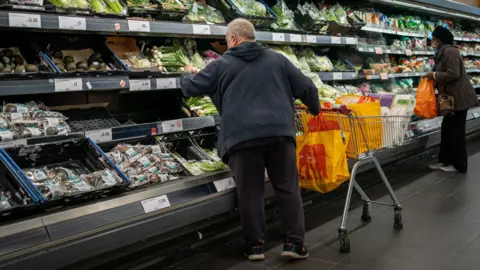Sainsbury’s, one of the leading grocery chains in the UK, is bracing for a challenging year ahead as it anticipates a significant dip in profits amidst an escalating price war among supermarkets. The retailer has forecasted that its profits from shop operations will either remain stagnant or fall in the upcoming fiscal year. The expected decline comes as the supermarket sector increasingly confronts external pressures, forcing companies to innovate strategies to attract price-sensitive customers.
As per recent declarations made by Sainsbury’s, the company’s profit is projected to decrease to around £1 billion. This strategic pivot towards lowering grocery prices is part of a broader effort to remain competitive in a market characterized by aggressive pricing tactics. Just last week, another giant in the industry, Tesco, acknowledged that it too might suffer considerable financial losses due to the necessity of price cuts. This situation follows an announcement by Asda, currently overseen by industry veteran Allen Leighton, indicating that grocery prices would be reduced significantly to bolster flagging store performance.
The intensification of competition to cut prices poses a silver lining for households grappling with the ongoing cost of living crisis. With essential expenses such as energy and water bills rising, the prospect of lower grocery prices could provide consumers with some much-needed respite. Nevertheless, while these reductions are likely to be welcomed by shoppers, Sainsbury’s has cautioned that the effect of its price cuts might not be substantial. The company estimates that its underlying retail profit could decline by approximately £36 million over the year—a figure that, while concerning, is markedly less than Tesco’s indicated potential hit of £400 million.
Interestingly, Sainsbury’s recently revealed that its full-year sales increased by an impressive 3.1%, reaching a total of £31.5 billion. Contributing to this growth, pre-tax profits experienced a notable enhancement, climbing from £277 million to £384 million. Despite this burgeoning revenue, underlying challenges persist. Notably, sales from Argos—a subsidiary of Sainsbury’s—continued to show a downward trend, albeit with signs of recovery as traffic to the brand’s website increased.
The retail giant also reported a significant downturn in fuel sales, which experienced an 8.9% drop to £4.7 billion. This decline was attributed to diminished consumer demand amid a backdrop of falling petrol and diesel prices, a trend prompted by reducing commodity prices in an increasingly competitive context. The implications of these price shifts were underscored by official data released recently, which indicated that the overall rate of inflation in the UK had decreased, resulting in a rate of 2.6% in March—down from 2.8% in February.
The backdrop against which Sainsbury’s is operating reveals a dual-edged sword: while the lower fuel costs have contributed positively to controlling inflation, they have also forced the retailer to reconsider its pricing strategies in the face of fierce competition. The combination of lifted sales figures with the realities of price warfare among competitors accentuates the precarious nature of retail profitability in the current economic landscape.
In conclusion, as Sainsbury’s navigates the complexities of reduced profitability against a backdrop of heightened pricing competition and cost-of-living concerns, its strategies will undoubtedly shape the dynamics of the grocery market in the UK. With competitors like Tesco and Asda taking aggressive action to retain customer loyalty through price reductions, the coming months will be critical for Sainsbury’s as it endeavors to balance customer needs with its financial sustainability. As the industry evolves, how effectively Sainsbury’s manages this challenge may dictate its ultimate success in the supermarket sector.



